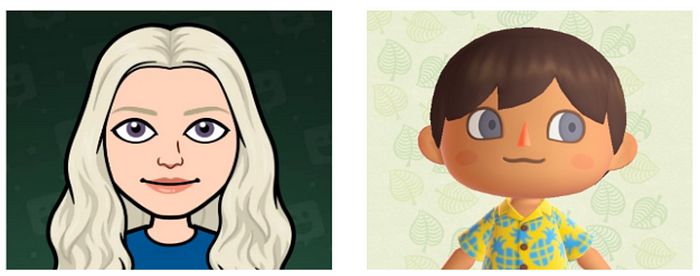Towards Inclusive Avatars: Disability Representation in Avatar Platforms
In this post, we summarize the findings of our research paper “Towards Inclusive Avatars: Disability Representation in Avatar Platforms”, which was accepted to the ACM Conference on Human Factors in Computing Systems (CHI) 2023. This paper was authored by Kelly Mack, Rai Ching Ling Hsu, Andrés Monroy-Hernández, Brian A. Smith, and Fannie Liu.

We use avatars in many digital spaces. From games, to text messaging and social media, these little characters represent us in interaction with other people online. However, they aren’t always inclusive of minoritized identities, like showing a person in a wheelchair. We don’t fully understand how people with disabilities want to represent themselves using avatars, nor do we have clear guidelines for making avatars more inclusive.
We interviewed 18 people with disabilities to understand how avatars currently and can best represent people with disabilities. We sampled a wide range of disabled experiences, including sensory disabilities, neurodivergence, chronic and mental health conditions, and fatness. Finally, we recognize that in doing this identity-focused work, understanding the experiences of people with other minoritized identities is critical. Therefore, we prioritized people who identified as gender-queer or queer and people of color.
Here’s a summary of what we learned.
When do people want to show their disability in avatars?
They feel safe. Participants didn’t want to show minoritized identities in spaces where they would experience considerable hate or trolling
Platforms can show their identities. Some platforms simply lack the options to show all parts of identity, like not being able to add a wheelchair. For example, one of our participants was a person who had Albinism and also a person who’s South Asian. Both of these identities often have some visible indicators in a person’s hair color and skin color. This participant explained that she sometimes felt the tension of wanting to be able to show both identities but not being sure the best way to do so, and oftentimes which one she chose to use was based on what the platform supported: “I couldn’t present well enough with avatars to look albino so I just made myself Brown. And then I got fond of presenting as South Asian so that I intentionally started doing it more.”

How do people want to show their disability in avatars?
Showing accessible technologies. Showing a wheelchair, a service dog, or compression garments all helped people show their disabilities. For people with invisible disabilities, this was particularly important since their disability might not otherwise be apparent. However, accessible technologies had to be represented carefully and accurately, as one participant explained: “Whenever somebody is posed in a chair and it doesn’t fit them, it just does not look right at all and that is so distracting. It’s like what if an avatar had on clothes that were too short or too big.”
Showing the full body of the avatar. There are some elements of disability that aren’t visible from the neck up. For example, our participants who identified as fat wanted to be able to show all of the ways that their fat sits on their body. Another person explained that one of their main adaptive to or accessible technologies, which was compression socks, isn’t visible from the head up.
Customizing text on avatars. Participants, especially with more invisible conditions or disabilities like ADHD, Autism, or mental health or chronic conditions, found that they could express pieces of them by controlling what the avatar says. For example, rather than show her avatar looking tired to show her symptoms flaring, one participant wanted to connect to disability culture and have her avatar say “no spoons left.” She included this phrase to connect to chronic illness culture and Christine Miserandino’s “Spoon Theory”, where people talk about energy and capability in terms of spoons.
Why do people want to show their disability in avatars?
To show pride in their identity. After dealing with internalized and externalized biases and stigma, participants wanted to demonstrate their pride in all virtual spaces: “I spent so much time getting comfortable with who I am … I’m not interested in not being that in every space that I can as soon as possible.”
To convey fluctuating abilities. Disability is often not static. People’s abilities, and the assistive technologies that they use, change overtime. Participants wanted to use their avatars to reflect these differences. For example, one participant explained: “I would have [one version of my avatar] for when I’m nonverbal, one for when I have a migraine, one for when I’m triggered and just need to withdraw.”
How can avatar platforms be more inclusive?

Overall, our participants found avatars to be useful to convey disability because they are hyper-customizable, easy to update, creative and can look different than their physical selves if they want it. To further embrace these characteristics, we suggest that avatar platforms consider the following:
Support customizability and easy change
- Allow customization of body part sizes: notably, allowing users to change the way weight sits on the body, and the length/presence of limbs is important for disabled and fat representation.
- Provide default poses that show more than the head: many aspects of disability, such as assistive technology use and body size, are most visible from the neck down.
- Allow color pickers wherever possible: participants felt limited and frustrated in selecting their skin and hair color from a limited palette. Sometimes colors of other elements, like assistive technology, were important for people’s self expression.
- Allow users to make multiple, saved versions of avatars: participants wanted different versions of avatars that expressed different states of disability (e.g., symptoms, assistive technology use), or may or may not present disability. Switching between versions also must be easy to allow for seamless identity representation in different contexts.
Make disabled and multiply-minoritized users feel welcomed
- Do not block identity representation with paywalls: do not require users to pay for features that are important for representing a core identity (e.g., hairstyles, skin tones, assistive devices)
- Make avatars accessible to create and consume: this includes making sure avatars have alt text, the associated text has proper color contrast, and that avatars can be created and consumed with only keyboard access.
- Ensure features can be combined seamlessly: for example, check that people with a variety of body types still look realistic when posed in a wheelchair. Check that assistive devices look natural on people with a variety of skin tones. This is especially important for multiply minoritized avatar users.
Engage with disabled communities
- Work with disabled people: disabled communities can help with designs for showing disability avatars (e.g., assistive technology).
- Avoid perpetuating harmful stereotypical representations: talking with disabled communities can help avoid these pitfalls
We hope that this work spurs initiatives towards making avatars that better represent disability. We invite you to read our paper for more details.
